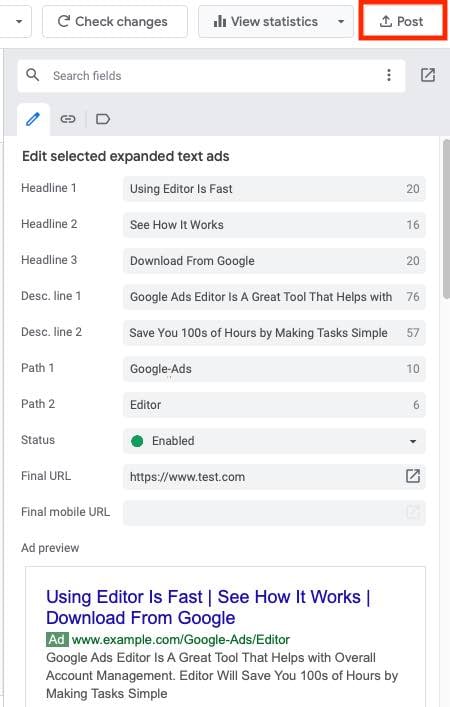

Now you might think this is getting too technical already, but I will spear you with the technical aspects, since wecan track provides a JavaScript tag and WordPress plugin that will handle them for you ( you can find more information on how to make use of those here). Now, you can make use of that to help you track conversions properly by using the affiliate networks’ API, Postback URL and SubIDs.
#GOOGLE ADS EDITOR TUTORIAL CODE#
You need to consider that advertisers already placed a pixel or code of the affiliate network on their website in order to trigger conversion events. User generated a sale on merchant’s websiteĪ lot of affiliate publishers have the misconception that it is not possible to track conversions that happen on the merchant’s website in Google Ads without placing a pixel on their website, but it is actually quite easy once you understand the data flow.User clicked on affiliate link leading to merchant.Now a very simple overview of conversions for an affiliate publisher could look like this: Do you want people to interact with your content, do you want them to sign up for a newsletter, do you want someone to click on an affiliate link or do you actually want someone to buy a product? Now, you can have multiple goals that you would like to accomplish with your campaigns, but it is essential that you define each one of them first and create a small overview for yourself. So let’s start with the first chapter of this guide, which will explain to you how to set up conversion tracking in Google Ads as an affiliate publisher.īefore you start setting up any Google Ads campaigns you need to think about what you would like to accomplish with your campaigns. You need to know whether and how your campaigns perform on EVERY dimension and not base your decisions on any guesses. Now, having that straightened out, let me point out the utmost important aspect to run profitable campaigns on Google Ads: So make sure you read up on the SEA and PPC policies within the affiliate networks, or just get in contact with your merchants to clear things up.įor example advertisers usually forbid the use of brand keywords, but this won’t prohibit you from using keywords related to products, services or your own brand. There are some rules you will have to follow as an affiliate marketer though, but these are defined by the advertisers and affiliate networks rather than by Google. While Google Ads has ad policies everyone needs to follow, affiliate marketers can of course still make use of Google Ads and should if they want to get visitors to re-engage with their content. “Is it allowed to do Affiliate Marketing on Google Ads?”įirst of all, let’s get one misconception out of the way, namely that it is not allowed to use Google Ads as an affiliate marketer. Since I work with a lot of different affiliate publishers and have successfully created and optimized campaigns for multiple publishers, I am able to give you some very relevant insights, which will help you to set up and scale up profitable campaigns yourself. Some aspects will be focused on affiliate publishers because content about setting up Google Ads campaigns properly as an affiliate publisher is scarce at this point. Whether you are a beginner or not, does not matter. How to optimize and automate Google Ads campaigns as an affiliate marketer.How to monitor Google Ads campaigns as an affiliate marketer.How you can set up Google Ads campaigns as an affiliate marketer.How you can set up and retarget relevant audiences for your campaigns.How you can set up conversion tracking in Google Ads as an affiliate publisher.


 0 kommentar(er)
0 kommentar(er)
